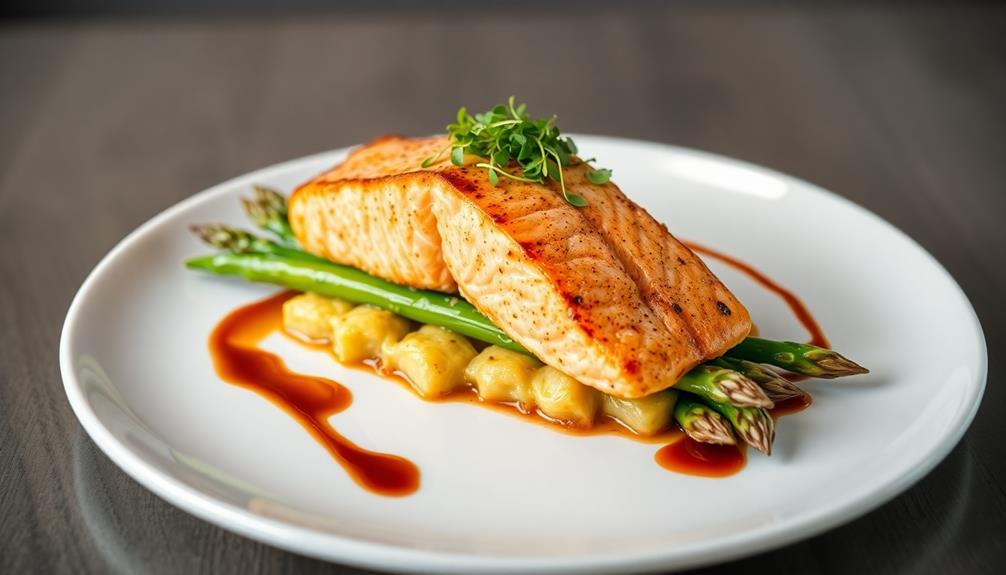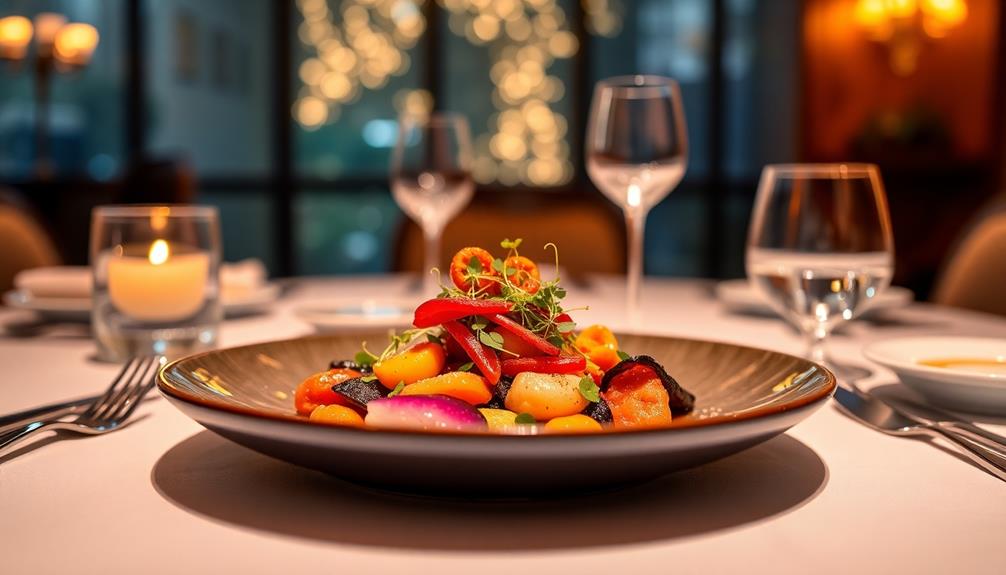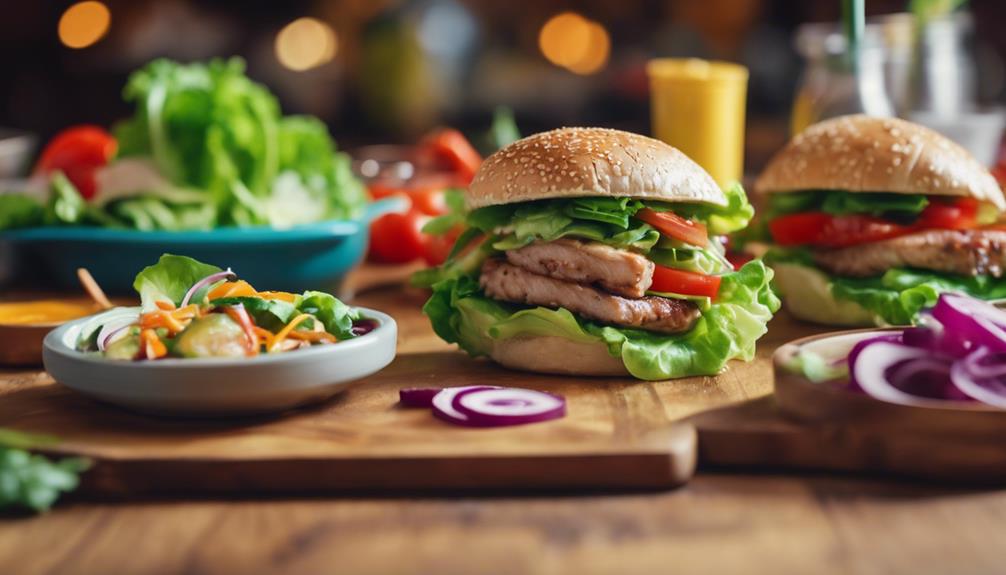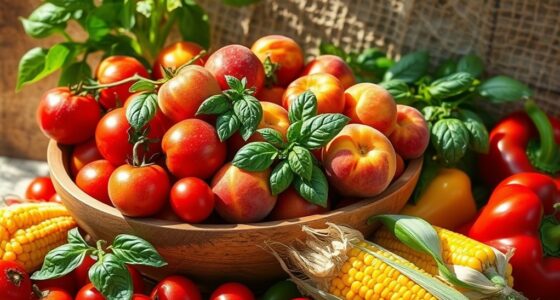When you enjoy fine dining, the presentation plays an essential role in your experience. It isn't just about how food looks; it's about how it affects your perception of taste. Beautifully arranged dishes can make a meal seem up to 29% tastier. Colors on the plate influence your appetite and mood—vibrant reds and yellows can boost your hunger. Textures also matter; a mix of creamy and crunchy can keep your palate intrigued. Each element works together to enhance your meal. There's so much more to explore about these psychological aspects and their impact on your dining adventures.
Key Takeaways
- Food presentation significantly impacts taste perception, with artistically arranged meals considered 29% tastier by diners.
- Color psychology plays a crucial role; vibrant colors stimulate appetite and influence emotional responses during dining.
- Effective plating techniques, like the Rule of Thirds and height variation, enhance visual appeal and dining enjoyment.
- Texture contrast, such as combining creamy and crispy elements, creates engaging sensory experiences that elevate meals.
- Ambience factors, including lighting and layout, further enhance the overall dining experience and influence taste perception.
The Importance of Food Presentation

Food presentation isn't just about making a dish look good; it genuinely affects how you perceive its taste. When you encounter a visually appealing plate, your anticipation heightens, and the meal feels more luxurious. Research shows that artistically arranged meals can be perceived as 29% tastier than those that are messily plated, highlighting the importance of food presentation in enhancing your dining experience.
Dishes from various cultures, like the vibrant Coconut Candy, exemplify how aesthetics can enhance flavor perception.
Plating techniques play a vital role in this process. The arrangement of food, combined with thoughtful use of color and texture, engages your senses and creates a memorable impression. This attention to detail can greatly influence customer satisfaction, as 85% of consumers consider color a primary reason for their culinary choices.
When dishes are beautifully presented, you're more likely to enjoy them, leading to better eating habits. This is especially true for children, who respond positively to meals served in varied shapes and sizes.
Ultimately, investing time in food presentation not only elevates the aesthetic appeal but also enhances your overall experience, encouraging repeat visits and fostering a lasting connection to the meal.
Psychological Impact of Colors

When you think about the colors on your plate, you mightn't realize how much they affect your appetite and mood.
For example, the vibrant red of a dish like Red-Braised Pork Belly can evoke feelings of warmth and comfort, making it more appealing.
Different colors can trigger emotional responses and influence your food choices, making your dining experience more enjoyable.
Color and Appetite Connection
There's no denying that the colors of what's on your plate can dramatically influence your appetite and overall dining experience. Research shows that vibrant colors can stimulate your appetite, with 85% of consumers citing color as a primary reason for their food choices.
In Indian cuisine, dishes like Mushroom Masala often showcase a rich blend of spices that not only enhance flavor but also add visual appeal. The way food is presented matters too—dishes served on white plates are often perceived as sweeter, while black plates enhance savory flavors.
Contrasting colors play a key role in making your meal more appealing. When different colors are used together, they catch your eye and make you want to dig in. This is where the Mere Exposure Effect comes into play; the more you see certain colors associated with food, the more you may crave them.
Warm colors like red and orange can excite your senses, while cool colors like blue might calm you down and even suppress your appetite. Understanding these connections can help you appreciate how color and presentation enhance your dining experience, making every meal not just a feast for the stomach, but for the eyes as well.
Emotional Responses to Colors
Colors do more than just enhance the visual appeal of your meal; they also trigger emotional responses that can greatly affect your dining experience. The psychological impact of colors in food presentation is profound, influencing both your appetite and flavor perception.
For instance, the vibrant colors of a dish like Dorayaki (Red Bean Pancake) can evoke feelings of nostalgia and comfort, making the dining experience more memorable.
Here are some key emotional responses associated with different colors:
- Red: Creates excitement and increases hunger.
- Yellow: Evokes happiness and positivity, making meals more enjoyable.
- Green: Represents freshness and health, often increasing your desire for nutritious choices.
- Blue: Tends to suppress appetite, creating a calming effect that may reduce cravings.
These emotional connections to color shape not only your dining mood but also your overall satisfaction.
For instance, research shows that vibrant colors can stimulate appetite, with 85% of consumers citing color as a primary reason for food choices.
Additionally, the right dinnerware color can enhance flavor perception, like white plates making sweet dishes pop and black plates amplifying savory flavors.
When chefs thoughtfully select colors, they can create a more engaging and memorable experience for you, making every meal a feast for both the eyes and the palate.
Color Preferences and Choices
Although personal preferences for colors can vary widely, they play an essential role in shaping your food choices and overall dining experience. Color greatly impacts your perception of food, with 85% of consumers citing it as a primary reason for their purchasing decisions.
When you encounter vibrant colors on a plate, such as the rich reds of a classic pasta with tomato sauce or the deep greens of fresh basil, your appetite and interest are stimulated, making the dishes more appealing and enhancing their perceived taste.
Different colors evoke various emotional responses; for instance, red and yellow can increase hunger, while blue may seem unappetizing. This psychological effect means that how chefs choose their color combinations through food plating and presentation techniques directly influences your satisfaction.
The Mere Exposure Effect also suggests that repeated exposure to certain color combinations will make you prefer those dishes more over time.
Interestingly, the color of the plate matters too. Meals served on white dishes are often perceived as more appetizing, especially for sweet foods, while black plates can enhance the appeal of savory dishes.
Techniques for Effective Plating

Effective plating techniques are essential for transforming a simple dish into an enchanting visual experience. By focusing on the presentation of food, you engage diners and enhance their overall enjoyment.
For instance, incorporating elements from traditional Indonesian desserts like Kue Putu can inspire unique textures and colors that elevate your plating.
Here are four key techniques to elevate your plating:
- Rule of Thirds: Position main components off-center to create a visually appealing arrangement that captures attention and draws the eye.
- Height: Utilize stacking techniques to add dimension and interest. A dish with varied heights invites curiosity and excitement.
- Clock Technique: Think of your plate as a clock face when arranging ingredients, allowing for balanced and harmonious presentation.
- Right Plate: Choose your plate wisely. A white plate can provide a stunning backdrop, allowing your vibrant ingredients to shine without distraction.
Incorporating contrasting textures, like creamy sauces paired with crispy garnishes, not only boosts the visual appeal but also enriches the sensory experience.
Role of Texture and Contrast

When it comes to food presentation, texture and contrast play an essential role in elevating your dining experience. Combining creamy sauces with crispy elements creates a delightful textural contrast that stimulates your senses. For instance, dishes like squash casserole can highlight a pleasing blend of smooth cheese and crunchy breadcrumbs.
Research shows that meals featuring varied textures are often perceived as more appealing and satisfying. This heightened appreciation encourages you to savor each bite, transforming the dining experience into something memorable. This phenomenon can be attributed to the science of mouth feel, which explores how different textures interact with our senses to create a multisensory eating experience. Crunchy, creamy, chewy, or smooth elements stimulate unique reactions, enhancing both taste perception and overall enjoyment. By thoughtfully incorporating a range of textures, meals can become not only more interesting but also more emotionally gratifying.
Incorporating ingredients with different textures not only enhances flavor perception but also adds complexity and sophistication to your dish. Imagine a plate that features silky purees alongside crunchy toppings or foams; the engaging mouthfeel keeps you intrigued and wanting more.
This thoughtful plating creates a visual appeal that's hard to resist, making your meal Instagram-worthy. A well-balanced dish that showcases contrasting textures invites curiosity and enhances your enjoyment.
Insights From Culinary Experts

Culinary experts agree that the art of food presentation plays a pivotal role in shaping your dining experience. Research shows that artistically arranged meals can be perceived as 29% tastier, proving that visual appeal directly influences your enjoyment.
Renowned chefs like Heiko Nieder emphasize the importance of innovative plating techniques, as they combine diverse flavors with artistic flair to create memorable moments. For instance, traditional Greek dishes like Horiatiko Psomi demonstrate how rustic presentation can enhance the overall dining experience.
Here are some insights from culinary professionals on enhancing your food presentation:
- Bold Colour: Integrating vibrant colors not only makes the dish pop but also stimulates your appetite.
- Varied Textures: Mixing textures engages your senses, making each bite a unique experience.
- Creative Plating: The freedom to innovate in plating allows chefs to express their personality and adapt to evolving trends.
- Social Channels: In today's digital age, visually stunning presentations encourage sharing on social media, amplifying the dining experience beyond the table.
The Influence of Ambience

Food presentation isn't the only factor that shapes your dining experience; the ambience of a restaurant plays a significant role as well. Think about how bright lighting can enhance the enjoyment of stronger flavors, while dim lighting sets the stage for more delicate cuisines. This tailored approach creates an overall atmosphere that complements the meal.
For instance, a dish like Nettle and Potato Soup can be made even more appealing when served in a cozy setting that highlights its creamy texture. The layout, including table spacing and comfort, also impacts your satisfaction, making it easier to enjoy each bite. You mightn't realize it, but sound plays a part too; higher-pitched tones can make dishes taste sweeter, while lower frequencies amplify savory flavors.
A visually appealing environment, where food is presented beautifully, evokes positive emotions that heighten your dining experience. When the aesthetic appeal of the surroundings aligns with the artistry of the dishes, it creates a holistic experience.
This interplay between environmental factors and food presentation guarantees that every element contributes to your satisfaction. Ultimately, the right ambience enhances not just what you eat, but how you feel while enjoying your meal, making every dining experience memorable.
Adapting to Modern Dining Trends

In today's dining landscape, the influence of modern trends is undeniable. With social media shaping the way we experience food, it's essential for restaurants to adapt their presentation.
You might be surprised to learn that 69% of millennials photograph their meals before eating. This shift means that plating your dishes has never been more vital. Here are some trends you should notice:
- Enhanced Takeout Presentation: As home dining grew during the pandemic, restaurants focused on making takeout meals visually stunning, much like the way Graveyard Taco Dip captures attention with its creative decorations and layers.
- Smaller Portions: Diners now prefer sampling multiple dishes, which opens up creative plating opportunities while reducing waste.
- Seasonal Ingredients: Highlighting fresh, local produce not only enhances flavor but also adds vibrant color to your plate.
- Minimalist Plating Style: Clean lines and simplicity draw attention to the essence of each dish, making the presentation itself an art form.
Future of Food Presentation

The future of food presentation is set to transform dramatically as restaurants embrace innovative techniques and sustainability. In this age of social media, where 69% of millennials photograph their meals before taking a bite, the art of plating food has never been more essential.
You'll notice that top chefs are focusing on creating beautiful plates that not only captivate the eye but also enhance the overall dining experience.
As culinary trends shift, sustainability will play a significant role in food presentation. Expect to see chefs using seasonal ingredients that not only look appealing but also resonate with eco-conscious consumers. This commitment to sustainability will guarantee that your meal is both visually stunning and environmentally friendly.
Moreover, the integration of technology in kitchens will streamline plating processes, allowing chefs to focus more on creativity and innovation. This balance between artistry and practicality will keep dining experiences fresh and exciting.
As you dine out in the future, prepare to witness a culinary landscape where every bite is a feast for the senses, and each plate tells a story of innovation, sustainability, and the relentless pursuit of beauty.
Frequently Asked Questions
What Is the Science Behind Food Presentation?
Food presentation combines aesthetics and psychology, affecting your perception of taste. Color, arrangement, and even dinnerware choices play an essential role in how you experience flavors, making visually appealing meals seem tastier and more enjoyable.
What Is the Psychology of Plating Food?
You know the saying, "You eat with your eyes first." The psychology of plating food engages your senses, influences your taste perceptions, and can enhance your overall experience. It's all about the visual allure!
Why Is Food Presentation Important in Restaurants?
Food presentation's essential in restaurants because it influences your perception of taste and enjoyment. You're more likely to savor a beautifully plated dish, enhancing your overall experience and making you want to share it with others.
What Are the Food Presentation Techniques?
Did you know that 85% of purchasing decisions are influenced by color? To enhance food presentation, utilize the Rule of Thirds, height, the Clock Technique, and textural contrasts for a visually appealing dining experience.
Conclusion
So, the next time you find yourself staring at a beautifully plated dish, remember: it's not just food, it's a work of art designed to dazzle your senses and maybe distract you from the fact that it costs more than your rent. Embrace the colors, textures, and that fancy drizzle—it's all part of the experience! Just don't forget to Instagram it before you dig in; after all, a meal's only as good as its online presence, right?










